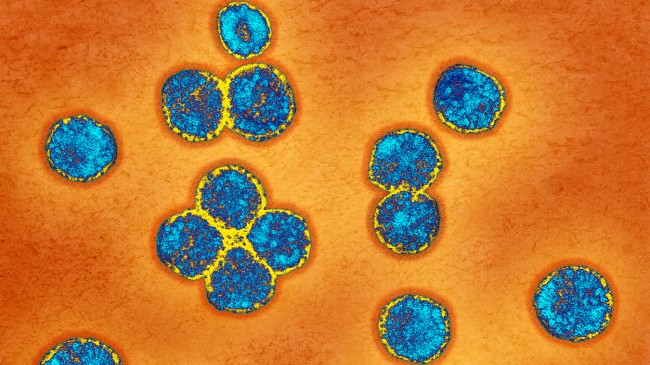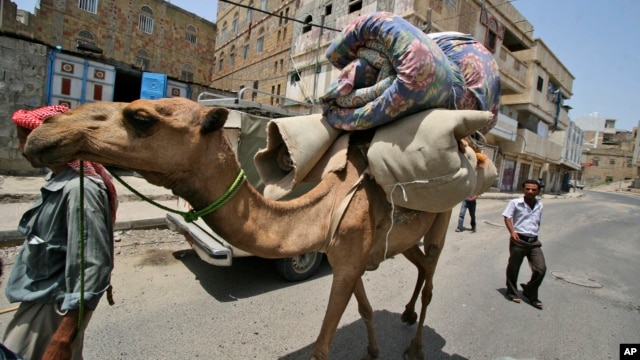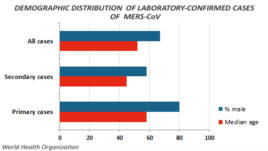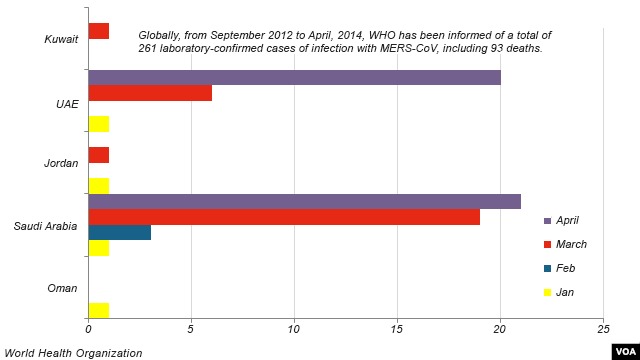Earth Watch Report - Epidemic Hazards
![]()
Image Source
***************************************************************************
….
Back
| Updated: |
Monday, 17 June, 2013 at 10:17 UTC |
| Description |
| Saudi Arabia says four more people have died from a new respiratory virus related to SARS, bringing the total number of deaths to 32 in the kingdom at the center of the growing crisis. Overall, nearly 40 people have died from the virus since September, mostly in Europe and the Middle East. Thatâs according to local officials and the World Health Organization. The Saudi Health Ministry also said on Monday that it confirmed three more cases of the virus, including in a 2-year-old child. Officials are still seeking clues on how easily it is spread between humans. The new virus is related to SARS, which killed some 800 people in a global epidemic in 2003, and belongs to a family of viruses that most often causes the common cold. |
….
Robert Roos ![*]() News Editor
News Editor
Jun 19, 2013 (CIDRAP News) – A study of the recent hospital outbreak of MERS-CoV (Middle East respiratory syndrome coronavirus) in Saudi Arabia reveals, among other things, that the virus spread in three hospitals and that some patients transmit it much more than others do.
The report, published today in the New England Journal of Medicine, shows that 21 of 23 cases involved person-to-person transmission in healthcare facilities, and that 9 cases were in hemodialysis patients.
Testing of more than 400 healthcare workers and household contacts of MERS patients turned up only 7 additional cases, the report says, which supports previous findings that the virus doesn’t spread very readily. Investigators found that some patients didn’t spread the virus to anyone else, but one of them infected seven others.
The report was prepared by a large international team with members from Saudi Arabia, Canada, the United Kingdom, and the United States.
All the hospitals involved are in Al-Hufuf (also spelled Al-Hofuf) in Al-Ahsa governorate of eastern Saudi Arabia. The report covers 23 confirmed cases that were identified between from Apr 1 to May 23; 11 probable cases also are considered part of the outbreak.
As of Jun 12, 15 of the 23 patients (65%) had died, 6 had recovered, and 2 remained hospitalized, the report says. Most of the patients were men, and the median age was 56. Disease manifestations included fever in 20 patients, cough in 20, shortness of breath in 11, and gastrointestinal symptoms in 8.
Most of the cases occurred at one general hospital, called hospital A, which has 150 beds, plus a dialysis unit. The event began on Apr 5 with admission of a patient with dizziness and sweating, followed by a fever 3 days later. He was not tested for MERS-CoV, but his son later had a confirmed case.
Another patient, who was on dialysis, was admitted Apr 6 and put in a room next to the first patient. By Apr 11 he had a fever, and he underwent dialysis in the hospital on Apr 11 and 13. Between Apr 14 and 30, MERS-Cov was confirmed in nine more patients who were receiving dialysis in hospital A. Eight of these cases developed before or within 1 day after infection control steps were taken in the dialysis unit.
One dialysis patient who had a confirmed MERS-CoV infection was admitted to a medical ward on Apr 21. In the following week, two other patients, located two and three rooms away from the dialysis patient, fell ill with the infection.
The virus spread to “hospital C” when a patient who was infected at hospital A underwent dialysis at hospital C while sick. Two other patients at the latter hospital subsequently were infected.
In addition, eight MERS-CoV patients were transferred to “hospital D,” a regional referral hospital. One of those patients passed the virus to two others at hospital D, and another passed it to a physician there, the authors concluded.
The team monitored 217 household contacts of patients with confirmed cases. They found only five cases—three confirmed and two probable—in adult relatives of three of the patients. One of them was treated at another hospital, “hospital B,” where the report lists no other cases.
Only two confirmed cases were detected among more than 200 healthcare workers who were monitored after exposure, according to the report.
In mapping transmission chains, the team found that one patient passed the infection to seven other people, one passed it to three others, and four transmitted it to two persons each. The authors say this variability in transmission is “reminiscent of SARS” (severe acute respiratory syndrome), which is caused by another coronavirus. Some patients in the SARS epidemic in 2003 were described as “super spreaders.”
The median incubation period in the outbreak was 5.2 days (95% confidence interval, 1.9 to 14.7 days). On the basis of recent MERS cases, the World Health Organization has said the incubation time may run as long as 10 to 14 days.
The investigators obtained full genome sequences from isolates from four patients. From a phylogenetic analysis of these sequences and from other data, they estimated that the date of the most recent common ancestor of MERS-CoV was Aug 18, 2011. This broadly agrees with the conclusion of a German team that, in a Lancet Infectious Diseases report this week, estimated the date of the most recent common ancestor as mid-2011.
The authors were unable to determine if the hospital outbreak involved just one, or more than one, transmission of the virus from the community.
Also, they couldn’t answer another key question about the virus: whether person-to-person transmission occurred through respiratory droplets or direct or indirect contact and whether aerosol transmission occurred over a distance of more than 1 meter.
The report says the pattern of the outbreak is consistent with the assumption that patients were infectious only when they had symptoms, but this doesn’t rule out transmission during the incubation period or during asymptomatic infection.
In other findings, the authors note that the survival rate was higher for patients who were identified through active surveillance than for those who were identified clinically. They say the likely reason was that active surveillance was better at picking up less-severe disease.
Assiri A, McGeer A, Perl RM, et al. Hospital outbreak of Middle East respiratory syndrome coronavirus. N Engl J Med 2013 (Early online publication). [Abstract]
******************************************************************************
Robert Roos ![*]() News Editor
News Editor
Jun 19, 2013 (CIDRAP News) – Eight Jordanians who had MERS-CoV (Middle East respiratory syndrome coronavirus) infections in a hospital outbreak more than a year ago, as determined by recent blood tests, didn’t quite match the profile of more recent cases, according to a CDC expert.
Most of the eight people did not have preexisting diseases, and one of them had no symptoms, said Mark Pallansch, PhD, director of the CDC’s Division of Viral Diseases.
The majority of MERS-CoV cases reported in recent months involved patients who had preexisting health problems such as diabetes or heart disease. And the asymptomatic case appears to be the first one reported.
The eight cases were associated with a hospital outbreak in Zarqa, Jordan, in April 2012. The cause of the outbreak was a mystery at the time, because MERS-CoV was not discovered until June of last year, when a Saudi man died of his infection.
The Jordan outbreak involved 11 cases, 2 of them fatal. Samples from the patients were stored, and later analysis led to confirmation of the virus in the two fatal cases. The WHO said the other cases probably were MERS, but that couldn’t be confirmed.
Earlier this week a Canadian Press report revealed that serologic (antibody) tests of 124 people related to the Jordan cluster had turned up 8 more cases, raising the number of confirmed cases in the outbreak to 10. The testing was done by the CDC in collaboration with Jordanian health officials.
Pallansch provided more details on the study in an interview. He cautioned that the findings are preliminary, because the CDC has had few serum samples from MERS-CoV patients with which to validate the two new serologic tests that were used.
“There’s always a caveat that we could have subsequent testing change some of the results,” he said.
Six of the eight cases were in healthcare workers and were part of the hospital illness cluster, Pallansch said.
One of the other two, the asymptomatic case, was in a household contact of one of the confirmed cases, he reported. The other one involved a healthcare worker who worked at the same hospital as the others. That person “by recall did have an illness, but was not considered part of the cluster at the time,” he said.
Among the other six case-patients, “there was a range of illness, but all were hospitalized, so it was reasonably severe,” Pallansch said.
He said he is not aware of any other asymptomatic MERS-CoV cases. Such cases are considered important because they suggest that people who aren’t sick can unknowingly spread the virus. Asymptomatic cases are likely to be discovered only through serologic tests, which for MERS-CoV have become available only recently.
Pallansch said he couldn’t give any information about how the first case-patient in the Jordanian cluster might have caught the virus or about the patients’ possible animal exposures. Officials are still working on their report, he explained.
“This is a report that will go back to the Jordanian Ministry of Health, and they’ll make decisions about how it will be disseminated or published,” he said.
See also:
Related Jun 17 CIDRAP News story
Nov 30, 2012, CIDRAP News story
******************************************************************************
Bloomberg Business Week
AP News
New MERS virus spreads easily, deadlier than SARS
June 19, 2013
LONDON (AP) — A mysterious new respiratory virus that originated in the Middle East spreads easily between people and appears more deadly than SARS, doctors reported Wednesday after investigating the biggest outbreak in Saudi Arabia.
More than 60 cases of what is now called MERS, including 38 deaths, have been recorded by the World Health Organization in the past year, mostly in Saudi Arabia. So far, illnesses haven’t spread as quickly as SARS did in 2003, ultimately triggering a global outbreak that killed about 800 people.
An international team of doctors who investigated nearly two dozen cases in eastern Saudi Arabia found the new coronavirus has some striking similarities to SARS. Unlike SARS, though, scientists remain baffled as to the source of MERS.
In a worrying finding, the team said MERS (Middle East respiratory syndrome) not only spreads easily between people, but within hospitals. That was also the case with SARS, a distant relative of the new virus.
“To me, this felt a lot like SARS did,” said Dr. Trish Perl, a senior hospital epidemiologist at Johns Hopkins Medicine, who was part of the team. Their report was published online Wednesday in the New England Journal of Medicine.
Perl said they couldn’t nail down how it was spread in every case — through droplets from sneezing or coughing, or a more indirect route. Some of the hospital patients weren’t close to the infected person, but somehow picked up the virus.
“In the right circumstances, the spread could be explosive,” said Perl, while emphasizing that the team only had a snapshot of one MERS cluster in Saudi Arabia.
Cases have continued to trickle in, and there appears to be an ongoing outbreak in Saudi Arabia. MERS cases have also been reported in Jordan, Qatar, the United Arab Emirates, Britain, France, Germany, Italy and Tunisia. Most have had a direct connection to the Middle East region.
In the Saudi cluster that was investigated, certain patients infected many more people than would be expected, Perl said. One patient who was receiving dialysis treatment spread MERS to seven others, including fellow dialysis patients at the same hospital. During SARS, such patients were known as “superspreaders” and effectively seeded outbreaks in numerous countries.
Perl and colleagues also concluded that symptoms of both diseases are similar, with an initial fever and cough that may last for a few days before pneumonia develops.
But MERS appears far more lethal. Compared to SARS’ 8 percent death rate, the fatality rate for MERS in the Saudi outbreak was about 65 percent, though the experts could be missing mild cases that might skew the figures.
While SARS was traced to bats before jumping to humans via civet cats, the source of the MERS virus remains a mystery. It is most closely related to a bat virus though some experts suspect people may be getting sick from animals like camels or goats. Another hypothesis is that infected bats may be contaminating foods like dates, commonly harvested and eaten in Saudi Arabia.
Read More Here
******************************************************************************
![]()
![]()
![]()
![]()
![]()
![]()
![]()
 The Saudi Health Ministry says it has recorded five new cases of a deadly SARS-like virus. (File Photo: Reuters)
The Saudi Health Ministry says it has recorded five new cases of a deadly SARS-like virus. (File Photo: Reuters)









 File photo: A view of Al-Mamlaka hospital in the Saudi capital Riyadh. (AFP/Fayez Nureldine)
File photo: A view of Al-Mamlaka hospital in the Saudi capital Riyadh. (AFP/Fayez Nureldine)


 News Editor
News Editor
 This undated electron microscope image made availalbe by the National Institute of Allergy and Infections Diseases – Rocky Mountain Laboratories shows a novel coronavirus particle, also known as the MERS virus, center. (AP / NIAID – RML)
This undated electron microscope image made availalbe by the National Institute of Allergy and Infections Diseases – Rocky Mountain Laboratories shows a novel coronavirus particle, also known as the MERS virus, center. (AP / NIAID – RML)





















 A view of the King Fahd hospital which has closed its emergency department banning the exit and entry of people and patients, on April 9, 2014 in Jeddah. AFP PHOTO/STR
A view of the King Fahd hospital which has closed its emergency department banning the exit and entry of people and patients, on April 9, 2014 in Jeddah. AFP PHOTO/STR

























